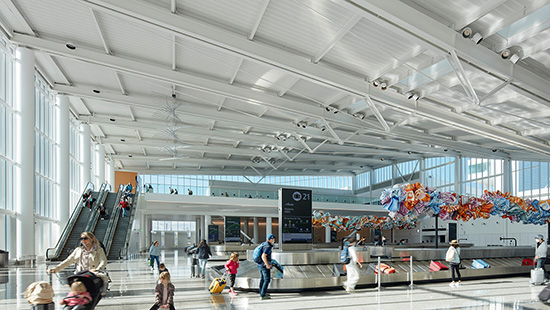|
Subscribe / Renew |
|
|
Contact Us |
|
| ► Subscribe to our Free Weekly Newsletter | |
| home | Welcome, sign in or click here to subscribe. | login |
Construction
| |
 |
February 6, 2023
National Finalist: Platinum Award
Transportation

KPFF Consulting Engineers
Project: SEA International Arrivals Facility
Client: Port of Seattle
The Port of Seattle recently opened its new International Arrivals Facility, replacing a 1970s facility with a dynamic structure nearly five times in size, doubling capacity and significantly speeding up the international arrivals process. Prior to the pandemic, Seattle-Tacoma International Airport experienced nine years of record-setting passenger growth, which the existing international facilities could not accommodate.
Upon arrival, passengers are greeted by a 780-foot-long aerial walkway 85 feet above an active jet taxilane. At the end, travelers enter the soaring Grand Hall, a multi-level, 450,000-square-foot light-filled space with an expanded baggage claim area and enhanced U.S. Customs and Border Protection facilities with staff offices. The new secure international corridor along the existing Concourse A can be configured to accommodate eight widebody aircraft gates for international flights with direct access to the IAF, or easily switch for a greater number of narrow-body domestic aircraft, depending on air traffic and airline needs.
Constructability constraints and a challenging environment required a creative structural system and construction process. It was critical for the port to maintain continuous airport operations with minimal interruption during construction. This meant that extensive phasing was required, so that only two gates were closed at any time.
Prefabricating many of the structural components saved time and space, including the 320-foot-long center span of the aerial walkway. The prefabricated center span weighed more than 1,500 tons and included deflection-sensitive systems, such as exterior cladding, plumbing and a moving walkway. This innovative construction process reduced active taxilane closures by at least 10 weeks and was key to maintaining critical operations at the airport.
The IAF features a unique aerial walkway that is the longest of its kind in the world. Spanning 600 feet and nearly 800 feet in total length, the new walkway soars 85 feet above the ground, allowing wide-body aircraft to taxi underneath. Striking views of nearby Mount Rainier greet visitors, orienting travelers amid the take-offs and landings on adjacent runways. The walkway connects arriving international passengers from the South Satellite across the top of Main Terminal to the new IAF. Innovative engineering allowed this steel structure to achieve its long span with minimal size and materials. The engineers created an economical structural design and saved hundreds of tons of steel by using cable trusses, steel pins, tuned mass dampers, and slide bearings.
Structural elements are prominently exposed throughout the Grand Hall including longspan (up to 165 feet) inverted king-post roof trusses. The trusses feature high-strength tension cables and custom, tapered angle assemblies that form each center V-post. Supporting each truss along the west side of the building are precast concrete shear walls that range in height from 42 feet to 80 feet to match the sloping roof geometry.
The precast walls serve double duty as gravity support for the roof and lower levels, and for resisting seismic and wind loads in the transverse direction of the building. This allows for a column-free space throughout the new concourse level.
Other Stories:
- National Finalist: Gold Award
Structural Systems - Best In State: Gold Award
Future Value To The Engineering Profession - Best In State: Gold Award
Social, Economic And Sustainable Design - Best In State: Gold Award
Complexity - Best In State: Gold Award
Exceeding Client/Owner Expectations - Best In State: Gold Award
Unique Or Innovative Application Of New Or Existing Techniques - National Finalist: Gold Award
Surveying/Mapping Technology - National Finalist: Gold Award
Special Projects - National Finalist: Gold Award
Structural Systems - Diversity And Inclusion Award: Mid-Sized Firm
- Diversity And Inclusion Award: Large Firm
- Engineer of the Year
- National Finalist: Gold Award
Transportation


